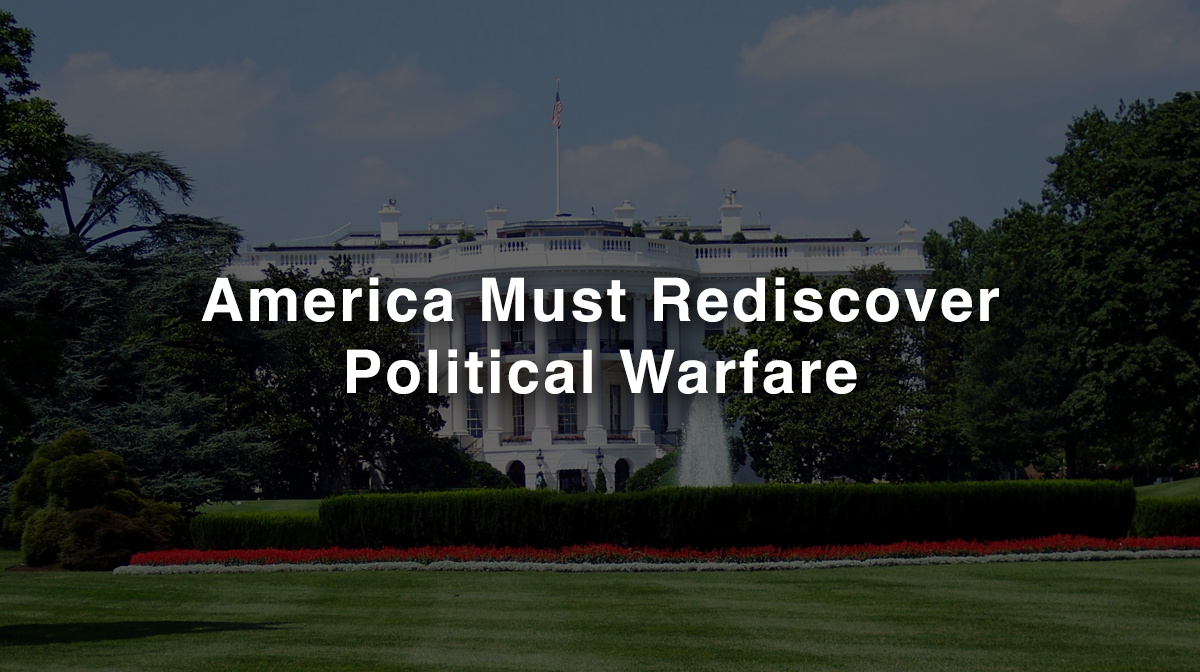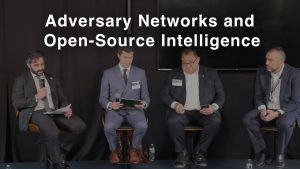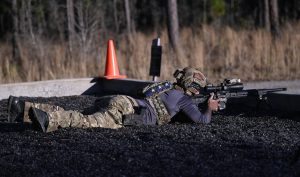Commentary by Jack Barry and Daniel Elkins.
The United States is overdependent on the Department of Defense (DoD) and Special Operations Forces (SOF) to counter threats that are political in nature.
In U.S. national security discussions, terms like “unconventional warfare” and “political warfare” are often used interchangeably to describe the murky space between peace and war where an increasing amount of global conflict is levied. The imprecision and conflation of these terms is symptomatic of a broader, more concerning trend of being slow and unilateral in reacting to adversaries who contest American interest and shape the battlefield without firing a bullet. The overall lack of understanding of political warfare causes strategic misalignment in how we should operate in and respond to an increasingly complex global order. If we do not make a deliberate shift toward a whole-of-government political warfare framework in which military operations support integrated diplomatic, informational, and economic efforts, we will continue to lose ground to nations who have mastered the art of full spectrum political warfare.
The distinction of political warfare and unconventional warfare is significant, and it would pay well to understand them completely. George Kennan, the architect of U.S. Cold War strategy, defined political warfare in 1948 as, “The employment of all the means at a nation’s command, short of war, to achieve its national objectives… from overt actions such as political alliances, economic measures, and ‘white’ propaganda to covert operations such as clandestine support of ‘friendly’ foreign elements, ‘black’ psychological warfare, and even encouragement of underground resistance in hostile states.”
Unconventional warfare (UW), by contrast has a much narrower definition. According to the 2014 edition of Joint Publication 3-05, UW consists of activities that enable a resistance movement or insurgency to coerce, disrupt, or overthrow a government or occupying power, usually by operating through underground or guerrilla forces in denied areas.
In other words, political warfare describes the full spectrum of available means of influence; unconventional warfare is one option. Yet, in Washington, “unconventional warfare” has become a catch-all label for almost any irregular, non-kinetic activity, which convolutes the policy discussion and triggers military-first responses to problems that require an interagency campaign. In contrast to Washington’s current state, Russia and China understand political warfare and apply it effectively.
China’s “Three Warfares” Doctrine (adopted by the Central Military Commission in 2003) integrates psychological warfare, media warfare, and legal warfare into all levels of statecraft. In the South China Sea, China has used maritime militias, selective enforcement of domestic law, economic coercion, and a barrage of state-controlled media to establish de facto control over disputed waters without utilizing military force.
Russia’s New Generation Warfare places information dominance at the center. Before and during the 2014 seizure of Crimea, Russia deployed a full-spectrum campaign that included cyberattacks, disinformation operations targeting both local and global audiences, economic blackmail via energy supply, and covert military action using “little green men.” The result was a strategic victory achieved with minimal overt combat.
These states have mastered the art of aligning diplomatic, informational, military, and economic tools (DIME) toward a single strategic objective. One reason they’re so adept at synchronizing all of their instruments of power is their centralized political systems, which the U.S., by design, does not have. The United States’ values, constitutional structure, and commitment to transparency put it at a disadvantage to orchestrate full spectrum political warfare like that of our adversaries. These constraints are a feature of our democracy, not a flaw, but they create a disadvantage when competing against authoritarian states that face no such checks.
By statute, the National Security Council (NSC) is supposed to coordinate political warfare strategies across all DIME agencies. In practice, however, the U.S. response to gray-zone challenges is fragmented, and hasn’t made meaningful progress to improve, despite the 2022 National Defense Strategy (NDS) recognizing the growing threat from “coercion below the level of armed conflict.” Operational responsibility often defaults to DoD because it has the most resources, the fastest decision-making processes, and the most mature operational infrastructure. This has led to what the Hudson Institute has called an “over-militarization of competition,” where the U.S. reflexively leans on SOF and kinetic capabilities to solve what are essentially political problems.
The closure of the State Department’s Global Engagement Center in 2025, as reported by the The Washington Post, underscores this imbalance. That center was one of the few dedicated interagency hubs for countering disinformation, a critical tool in the political warfare toolbelt.
The real-world cost of our inability to mount a sustained, whole-of-government political warfare campaign is that adversaries can reshape the operational environment virtually unchecked. A few examples:
- Since Russia’s annexation of Crimea from Ukraine, Russia has strengthened its hold through a combination of cultural outreach, propaganda, and economic leverage over Europe. While vital, western military aid to Ukraine addresses only the kinetic symptom, and leaves the preponderance of Russia’s strategy untouched.
- Beijing’s strategy in Taiwan is to precede an invasion with political isolation. They’re actively reshaping the information environment to degrade the island’s (and the world’s) will to resist, so that when a military operation begins, the fight is already half won.
- Iran’s influence in the middle east largely stemmed from its proxy networks, which, before being hollowed out by Iran, allowed it to shape outcomes beyond its borders without decisively committing its own forces, such as when the Houthis attacked Saudi oil infrastructure in 2019.
These examples demonstrate that when we fail to counter political warfare with political warfare, we lose strategic positioning and are perpetually forced to play catch-up on the battlefield.
This issue isn’t new, and it’s been highlighted by several think tanks and policy advocates. The Center for Strategic and International Studies’ “Return to Political Warfare” analysis makes the point clearly: adversaries wage integrated campaigns across all domains of their national power, but U.S. counter-strategies remain siloed and overly reliant on military options. We have no enduring mechanism to align economic statecraft, strategic communications, covert action, and military support toward a single political objective. The goal isn’t to pull SOF out of the fight, but to nest DoD operations smartly inside a broader political warfare strategy led by the NSC and executed across all agencies.
The Special Operations Association of America recommends starting with the following changes:
- Be precise with our words. Washington should retire “unconventional warfare” as a catch-all term in policy discussions. Replace it with “SOF support to political warfare,” making clear that UW is a subset, not the whole campaign.
- Resource the State Department, Treasury, and USAID for sustained competition. Build a robust interagency political warfare capacity. As the NDS notes, integrated deterrence requires influence, alliances, and economic leverage as much as it does ships and aircraft.
- Update doctrine and clarify agency roles in political warfare, ensuring DoD is a supporting arm rather than the lead planner.
- Institutionalize training and doctrine across the interagency so that senior leaders, not just SOF operators, understand how political warfare works.
Political warfare is something U.S. policymakers must come to understand, respect, and commit to practice in the way our adversaries do, or we will perpetually be one step behind them, reacting tactically to strategic defeats. But by synchronizing and implementing all elements of national power, we can protect American interests globally and prevent conflicts before they turn kinetic.





